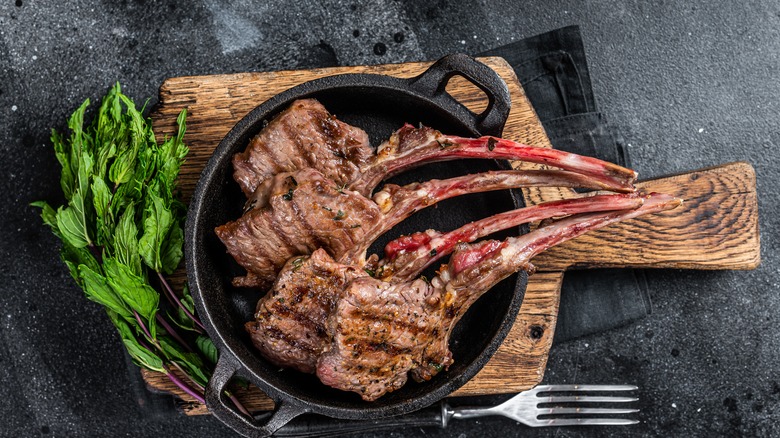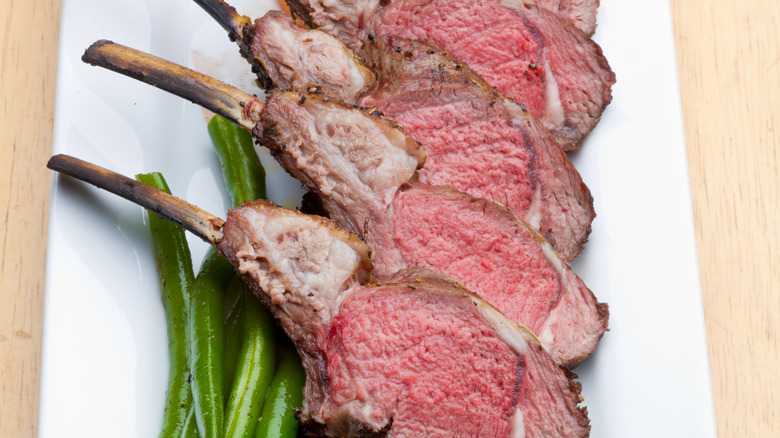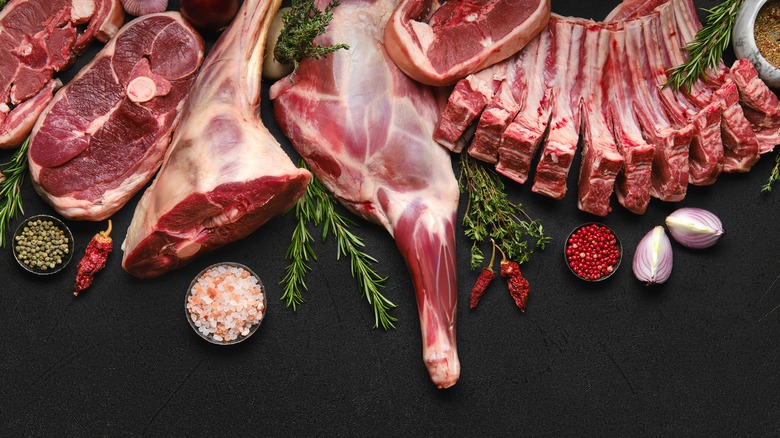Why It's Crucial To Oil Up Your Lamb Before Throwing It On The Grill
Burgers and hot dogs get all the glory during grilling season, but there are a lot of other meats that are amazing when they're cooked over an open flame, especially lamb. If you really want to up the wow factor at your next backyard dinner, try grilling some lamb racks or chops, or even a whole leg of lamb if you're feeling ambitious. Its delicate, gamey flavor works well with the charring you get from grilling, and when it's done right, even the staunchest lamb hater will find it hard to resist. The key to perfectly grilling lamb is to prep the meat properly before it hits the heat and make sure that it's well coated with oil so that it doesn't stick to the grates.
Lamb is a little bit finicky and delicate compared to beef, and it's typically more expensive, so take the time to get it right before you start cooking so that you don't end up with disappointing results. You don't need any special ingredients to get a cut of lamb cooked properly on the grill, just some good quality olive oil, lamb-friendly herbs and spices, and a meat thermometer.
Lamb prep
If you're attempting to cook lamb for the first time, or if you don't think you've gotten it right in the past, the most important thing to know about cooking it is that it requires a little extra prep and care.
The first thing to notice when you're buying lamb is that it usually has some excess fat. If you have a good relationship with your local butcher or meat counter staff, ask them if they'll trim some of that extra fat for you before you pack up your chops. If that's not an option, trim away some of the obvious fat that's surrounding the meat when you get it home. Excess fat will render on the grill and cause fire flare-ups, which will make your meat taste like a campfire.
The next step is to pat the meat dry and then season it with salt, herbs, and garlic, then coat it with whatever oil you'll be using to grill. Olive oil is a natural choice because its grassy flavor pairs well with the flavor of lamb. You can either marinate your lamb for a few hours or overnight, or you can oil it right before you grill. Either way, be sure that the entire surface of the meat gets coated with oil to prevent sticking — lamb is extra prone to it. It's also a good idea to oil the grill grates before you put the lamb on to cook.
Let the heat do its job
If you've properly oiled the lamb and preheated the grill so that the grates are at searing temperature (around 300 to 500 degrees Fahrenheit, according to Weber), the meat shouldn't stick. When you place it on the grill, however, don't fuss around with the pieces until the searing is done. When the surface of the meat is properly seared, it should come away from the grill grate very easily. If the grill isn't hot enough or the meat isn't seared fully, it will bond with the metal and you'll get tearing. It takes about two or three minutes to sear each side.
Once your sides are seared, cook the lamb to temperature over medium-high heat. Absolutely use a meat thermometer for lamb because it is easy to overcook. While you may be familiar with how burgers and steaks look and feel when they're cooked to temperature, lamb is a different animal (literally) and the tender meat feels softer if you use the "poke" test to check if the meat is done.
If you control the heat of the grill, make sure your meat is covered in a film of oil, and use a meat thermometer to prevent overcooking, you'll always get a deep, brown crust on the outside of your lamb and a tender juicy inside, with no sticking, tearing, or struggle.


